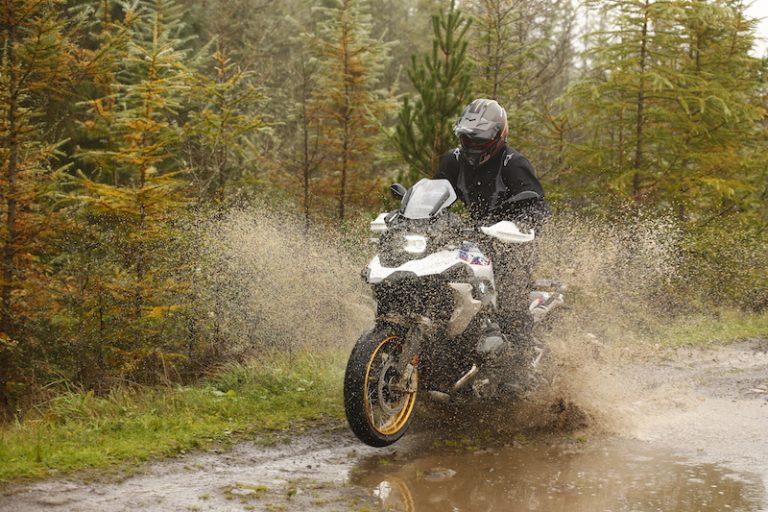It’s a problem. When you already make the best-selling, best-loved and arguably best-performing adventure bike ever made, how are you going to make it better? If you are already at 10 on every dial, where are you going to go from there?
Well, it seems that the answer, like the question, can be found in the iconic film Spinal Tap. Because, for the latest incarnation of their flagship adventure bike, the R 1250 GS, BMW decided the only way to go was to allow all their dials to go to 11. And on the basis of ABR’s recent test, that little bit extra is pretty damn effective.
Achieve the impossible
So, how has BMW achieved the seemingly impossible? Well, the first thing the company has done is give the GS a tad more capacity, so, after a decade and a half of being a 1200, it’s now a 1250. On paper, it’s not that much, but as the original motor was actually only 1170 cc and the new one is 1254, then that’s actually an 84 cc hike, and as we all know, there is no replacement for displacement. But the capacity is not the big story.
The major change that has transformed the ever-reliable boxer engine in the new 1250 is the addition of the new Shift Cam system. In layman’s terms this is variable inlet valve timing that allows the bike to transfer from shorter duration low-lift cams when the bike is under low load, to longer duration high-lift cams when the bike is under heavy load.
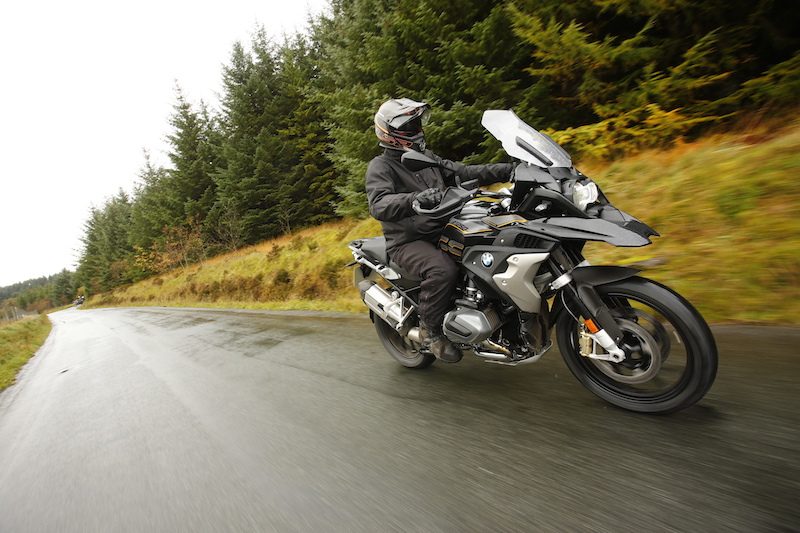
But this is no clunky, stepped change that transforms the bike from Dr Jekyll to Mr Hyde like some oversized motocross bike hitting the powerband. The new tech is controlled by an electronic actuator on the end of the camshaft and, thanks to software cleverer than anyone that will ever sling a leg over this bike, allows it to happen completely seamlessly.
The end result of both the new capacity and the Shift Cam system is to give the new bike substantially more power, far smoother and more linear power delivery and, maybe less importantly, better economy in the lower rev range. BMW claims an impressive 11 more bhp, taking the already super tanker powerful motor from 125 to 136 bhp, with torque rising from an already impressive 125 Nm to a figure of 143 Nm for the new model. To save you getting out the calculator, that’s around 9% more power and 14% more torque – a substantial increase that appears to justify the new trickery concealed beneath those familiar cam covers.
Drenched roads
But all the figures and marketing claims in the world will count for nothing unless the 1250 can cut the mustard on the road and, perhaps less importantly, on the dirt. And while we might have hoped to test the BMW on the sweeping and baking hot roads of Portugal, the venue for the European launch, ABR’s chance to get hold of the new bike, was in the slightly less glamorous setting of the South Wales valleys, where it appeared that sweeping though completely drenched roads were far more on the cards.
For British riders, how the bike performs in these familiar conditions may be more important than the nirvana of year-round sun and sparse traffic, so we set off for the BMW Off-Road Skills centre just outside Swansea, clad head to toe in our best waterproof kit.
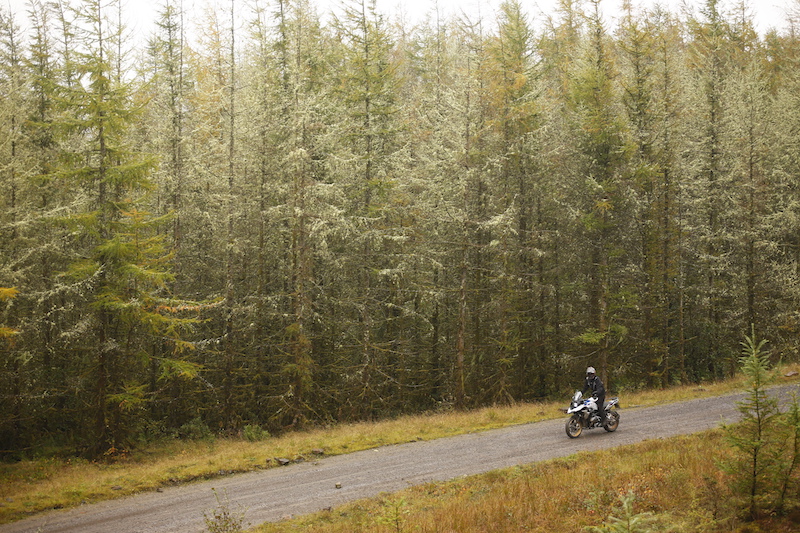
Outside the centre and opposite the fleet of R1200GS customer machines, the new bikes sat glistening and slightly moist in the morning light. Unexpectedly, there’s three different versions to pour over, all of which seem to get progressively more attractive as the price goes up – funny that…
The base model is resplendent with a light blue beak and tank panels backed up with silver and black in equal measure. The black theme extends to the spoked wheels with what is visible of the iconic frame picked out in silver, and there’s a stepped twin seat with a cool embossed GS logo on the front of the pillion mount.
Identical looks
It’s a great looking machine, but sadly the blue is so similar to last year’s offering just over the car park, that it’s hard to be to effusive about this version especially as, bar the engine changes and a few other tweaks, the 2019 1250 is pretty damn identical to the 2018 1200. Buy this one and you’ll either have to tell people you’ve bought the new bike or buy some big 1250 stickers for the side of the tank …
Next up is the all-new and not seen before ‘exclusive’ version, and now we’re talking. The ‘exclusive’ is so cool it doesn’t even need a capital letter and sits moodily in shades of jet black and gun metal grey, the massive GS on the tank picked out with yellow highlights which extend into detailing and the moniker on the upper fairing.
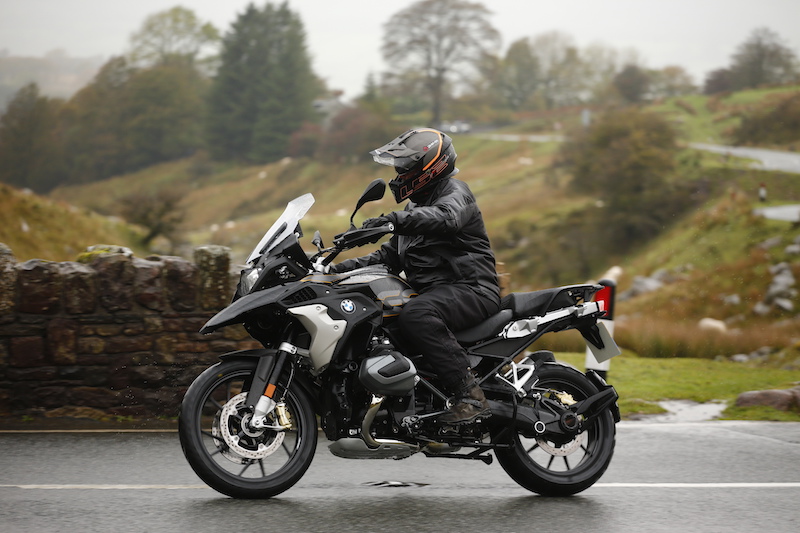
The front fairing panels are alloy here too, and the frame gets the gunmetal treatment, while the rear rack is Henry Ford Black. The exclusive also ditches the wire wheels in favour of black, ten-spoke alloys, the rear having a deep and sexy dish to highlight the hollow spindle of the single sider. Put side by side with the base model there’s no comparison – the ‘exclusive’ rocks.
And then to the jewel in the crown of this triumvirate, we have the HP model, and the one most will have seen on the advance publicity. And before anyone else says it, yes it does look uncannily like an Africa Twin. BMW has been losing a proportion of its sales to the cheaper and slimmer Honda, but it would surely only be a cynic to think that the similarity between the two models was intentional, wouldn’t it?
Simply stunning
However, the similarity occurred, the Rallye HP model, looks simply stunning in the flesh. The rich white flanks of the tank are emblazoned with a 1250 logo picked out in red and blue, with the same blue covering the central tank panel with an understated HP logo on the back ends of the beak fairing. The red, white and blue theme extends to the sides of the slim one-piece seat and the side tubing of the space frame is picked out in white against the black and grey boxer engine. And to finish off – well it had to be gold spoked wheels didn’t it?
With the HPs already bagged, I elected to try the ‘exclusive’ first, working on the premise that if I could ride the most road-based model on the road in the morning, I stood a good chance of taking the HP model out on the rough stuff in the afternoon – up here for thinking, down there for dancing! Sitting on the new GS1250, the familiar dimensions are straight away there – the slim waist, the swoop out of the tank up towards those incredibly wide and instantly recognisable bars – you can tell you are on a BMW even in Braille.
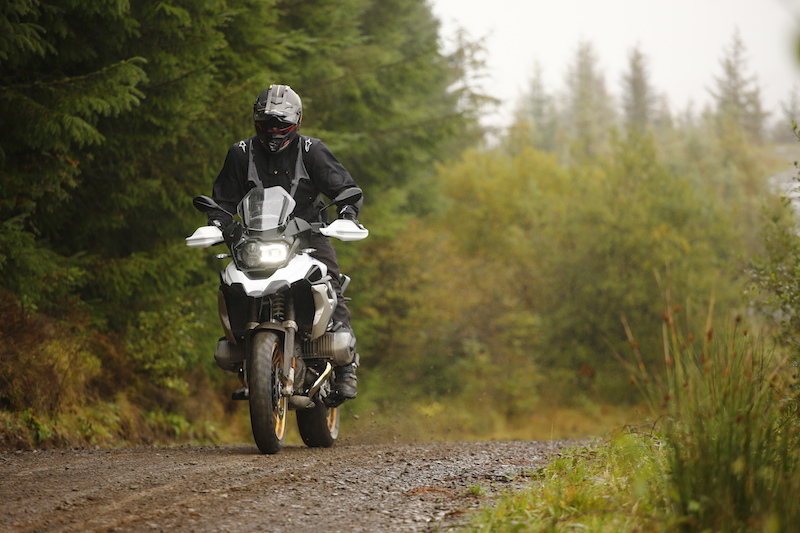
What you may not have experienced before is the now enormous TFT (Thin Film Transistor) screen that forms the dashboard and information console in the vast cockpit. The screen is an incredible 6.5 inches wide (I’ve had smaller televisions than that) and dominates the view below the similarly large SatNav.
With the key tucked away in my pocket, a simple push on a button where the key used to be, a nice if unintentionally retro touch, sees the screen come to light with a cool opening sequence before settling with a view of a digital tacho, speedo and a startling array of other information that will have old bikers paling with amazement – how did we ever ride bikes before TFT? Hitting the starter sees the boxer fire up instantly with that iconic side lurch from the big pistons, the red line on the tacho starting low before the engine is up to temperature.
Astounding list of options
Before setting off I take a look through the infinite options available through the combination of the turn wheel on the left grip and the selection buttons to the right of it. The new 1250 has a truly astounding list of options and electronic riding systems available, and to hope to learn them in the course of a few hours isn’t going to happen. But just to run through some the list gives you an impression of how adjustable the GS can be.
First off, you can select the riding mode from Enduro, Rain, Road or Dynamic, and if you insert an additional chip under the seat, you can also select a further two modes of Dynamic Pro and Enduro Pro, both of which can be further programmed. The traction control can also be varied via this chip in the Dynamic Traction control mode but, without the chip, the traction control is still selectable and adjustable.
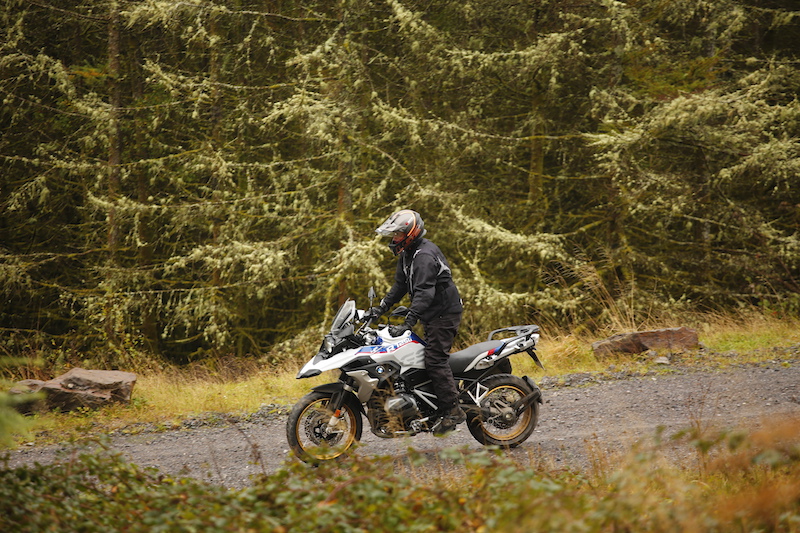
Dynamic Brake control is also an option which ensures that the accelerator is shut off during braking – a sensible option if you are the type of rider that fails to properly roll off the throttle when hitting the anchors. The same system also reduces the effect of drive torque during braking to increase the efficiency of the rear brake. Clever stuff.
Backing up the riding and braking modes, the 1250 has the next generation of electronically controlled suspension so you can fine-tune the bike to your every whim at both the back and the front, making adjustments for terrain, load, speed and just about everything else.
Virtual handbrake
To finish what is getting to be an exhaustive list, the bike now also has Automatic Stability Control (ASC) as standard to ensure the best traction at all times and, possibly the best addition or those intimidated by the weight of the GS, the bike has the genius of a virtual hand brake.
OK, BMW calls it Hill Start control, but the effect is much the same – come to a halt on a slope of more than five degrees and the computers hold the brakes until you pull away. There’s a symbol on the dash to tell you it’s engaged which dutifully disappears once you are rolling. You will never fluff a pull away again.
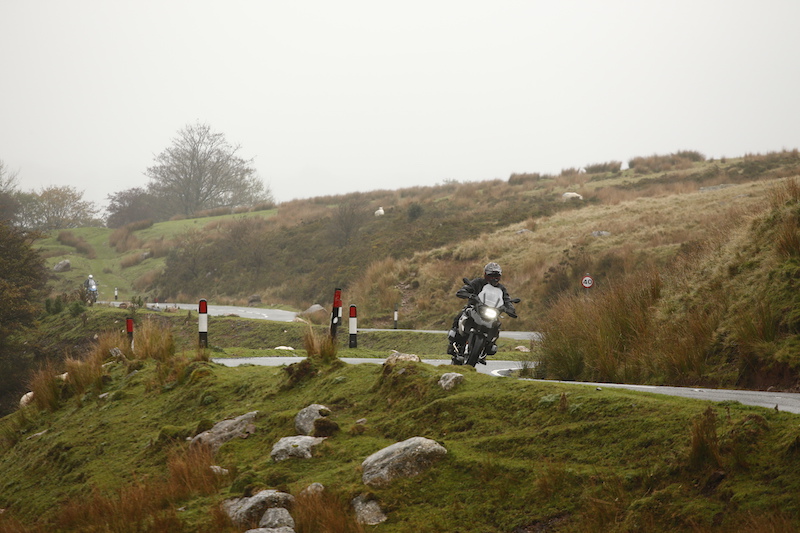
Outside the engine, braking and other monitoring and control systems, the same thumbwheel and control allows you to control your phone, media devices and of course the large SatNav above the TFT screen. Set it to Cape Town and the bike will get you there.
OK so enough of the tech – what does the bike ride like? Well, having selected the rain mode as a good starting point for the now light precipitation that was beginning to test the outer layers of waterproofs, position two on the heated grips and a similarly middle of the road suspension option, I set out onto the Welsh roads aboard my black Teutonic mount.
Balanced and planted
And as happens every time you ride a GS, the not inconsiderable 250-odd kilos of weight seems to miraculously halve, leaving you under the impression you’ve stepped out on a sleek 500cc trailie rather than a fully-fledged adventure bike. If you’ve never ridden a GS, you can never know just how balanced and planted they are from the moment you drop the clutch to the moment you stop.
For the hundreds of thousands of GS owners worldwide – you know exactly what I mean. The new bike is marginally heavier than the 1200 by 5kg, but a lot of that comes from the new LED headlight which was a common upgrade on the older model, and a bit from the new dashboard. If you can pick out a gain of 5kg on a bike like this, you should think about a career working for BMW, not reading about them.
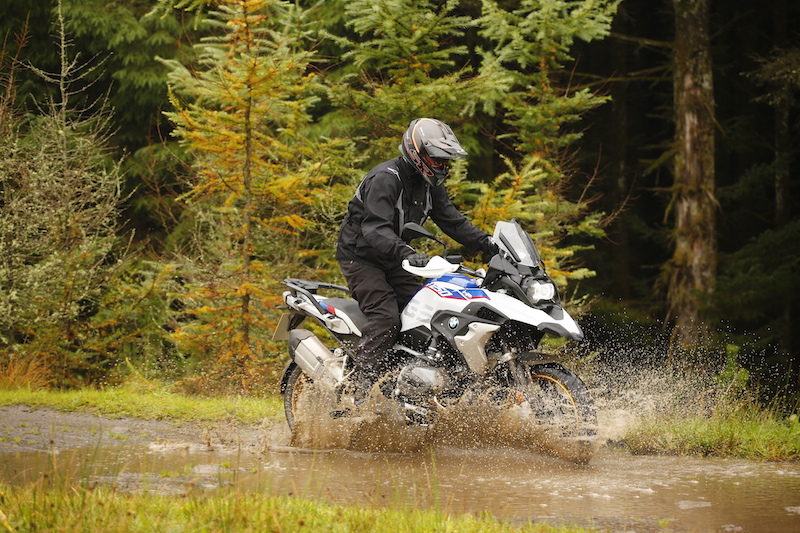
Free from the roundabouts and side roads of Ystradgynlais and out onto the A roads, I got the chance to open the taps on the 1250 and see just how smooth the new Shift Cam engine is. I wasn’t disappointed. From the very lowest revs, the bike’s torque curve is billiard table smooth right through the range. The gear shift has a ‘shift assist system’, meaning you don’t even need to shut off the clutch if you don’t feel like it, just bury the throttle and watch the landscape blur to the sound of those big twin cylinders in front of your shins.
Of course, the possibility of any such shenanigans on rain-soaked and debris-heavy Welsh roads is fairly limited, and you are hard pushed to find many places that allow flaunting of the national speed limits, let alone wanting to hoon a box-fresh adventure bike around blind corners.
Smooth power delivery
But even without an autobahn to fully test the top end grunt of the bike, the smoothness of the power delivery shines through, though any attempts to identify the switching point of those new cams is entirely fruitless. However, the system manages it, the transition between the low load and high load cams occurs with an unnoticed gossamer touch.
In terms of the bike’s handling, the smooth power delivery can only assist the bike’s predictably rock-solid road holding and handling. The front telelever system behaves unlike any conventional fork you may have ridden with, but in an entirely good way, and backed up by the electronically controlled rear shock, you have to be working hard to get the GS anywhere near out of shape.
From fast A-roads to twisty B roads up into the Brecon Beacons, the BMW feels both comfortable and comforting to ride, regardless of the foul weather that is has enveloped the landscape during the course of the morning ride. Yes, the footpegs are far too small and far better without the rubber pads in place, but if this is the extent of the gripes, then I don’t think the engineers are going to lose much sleep.
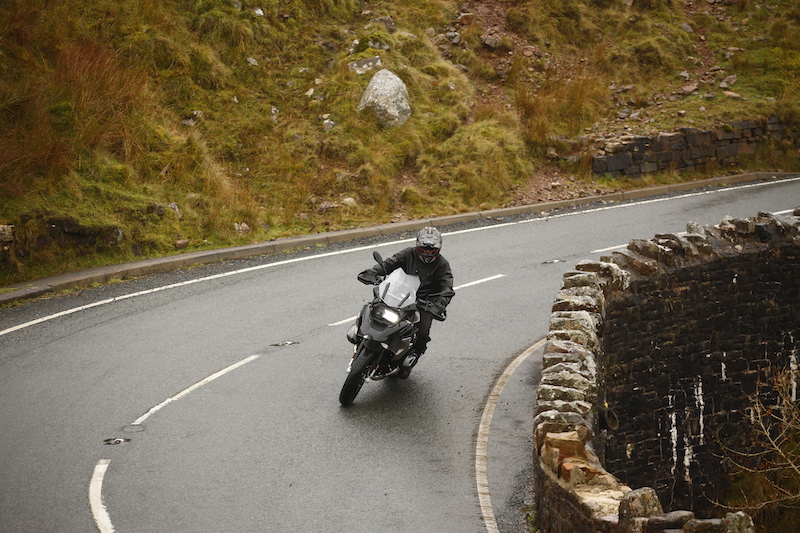
Over lunch at the Café Sarn Helen it’s a chance to dry out a bit and talk through the merits of the bike with Off-Road guru and BMW Off-Road Skills head honcho Simon Pavey. As a veteran of many off-road races and long-distance events, including being half of the only father and son duo to complete the Dakar, Pavey is happy to sing the praises of the GS family at any occasion given and is a particular fan of the 1200 as a platform for both on and off-road adventures. His view of the new bike’s capabilities seems to confirm my already positive response to the new generation in the GS lineage.
Fortified by the Welsh beef chilli and strong tea, my plan to get to the HP version for the off-road section of the day comes to fruition, and as we set off towards the Walters Arena, a vast area of former open-cast mine traversed by a number of trails that’s the location for Pavey’s off-road schools, I’m getting to know the dazzling liveried machine.
Serrated pegs a revelation
The seat is certainly much firmer on the road, but the lack of a step allows easy movement back and forth and its lowered height seems sensible for slow-speed manoeuvres on such a physically big bike. The wider serrated pegs are a revelation compared to those on the ‘exclusive’ and hold my TCX adventure boots firmly in place.
The brake pedal is similarly serrated on both bikes, but unlike the previous GSA, there is no fold-down tip to make the adjustment required for braking while standing, which is a bad omission for a bike intended to do more off-road than the other models.
When we reach the dirt road that leads up into the forest, it’s straight on the pegs for me to see what this bad boy is made of and wow, this thing is unreal on loose going. While every cell of your brain is telling you the 250kg bike on road-based tyres will be a complete liability on the dirt, the exact opposite is true.
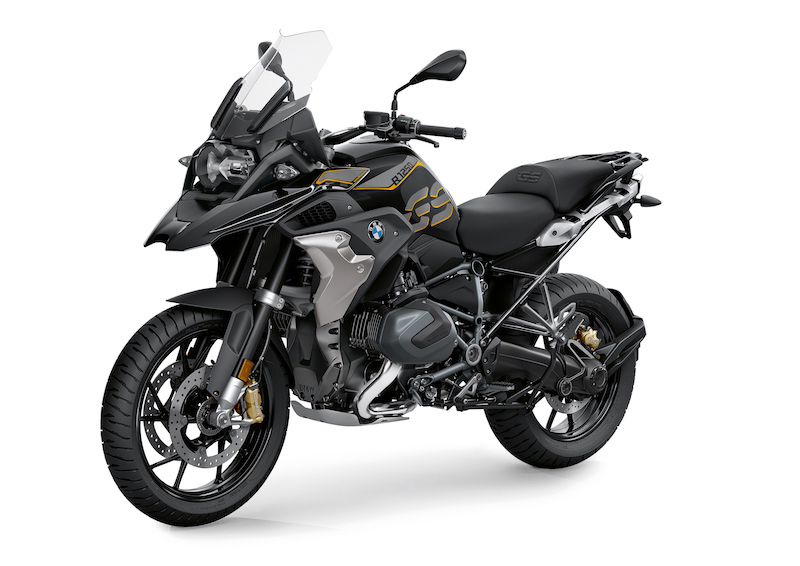
With the power and suspension settings in off-road mode, the R 1250 GS sticks to the ground like gum to a shoe, powering the machine forward with beautiful precision. At normal rather than heroic off-road speeds, the higher lift cams are not being called on too often, but the buttery smoothness of the power delivery on the shorter cams makes for wonderful riding.
Exiting the turns, the boxer motor can make the back end step out at will, but the traction control settings make sure things don’t get too far out of hand. OK, so I’m not saying that there’s not an ever-present possibility of things going wrong, and going wrong in a pretty big way, but that is no different to riding off-road on any of the big adventure bikes away from the blacktop. Putting that firmly to one side, for the moment I’m loving the experience and confidence of pushing the GS further than I thought I would ever want to – it’s that good.
Better stability and superior handling
In fact, having ridden my own Yamaha XT660Z Ténéré to South Wales to test the BMW, I found the GS easier to ride off-road than the smaller, lighter and less powerful machine, and after only ten or so minutes on the dirt I was chucking the thing around, blasting it through deep puddles and generally enjoying the BMW. The bike’s lower centre of gravity, better stability and superior handling leave my lowly Yam feeling decidedly agricultural in comparison.
With the off-road time coming to a close, I stayed on the HP model back down from the hills, and with a fast and straight blast allowing full gas Shift Cams to engage, the bike felt just as stable as the ‘exclusive’ model. With little basic changes in geometry between the two there shouldn’t be, but it’s good to know that if you pick the off-road focussed GS, then there’s no compromise on-road manners.
When we got back in sight of the Off-Road Skills Centre, the inevitable return of the BMW loomed like a dark cloud. With a further 75 miles to cover before returning home. I’d have gladly kept going on the exquisite 1250.

ABR verdict
As a commuter
To choose the R 1250 GS as a day-to-day commuter would be both a curious and ultimately foolish choice, unless your commute was over big miles and on fast roads. This is a bike that needs space to roam free and will not respond well to the confines of slow speed filtering and stop-start traffic.
As a weekend tourer
The 1250 is a natural weekend tourer, rewarding its owners with mile after mile of enjoyable and grin-inducing riding. If you get bored of this BMW, you need medical intervention.
As an off-roader
The BMW has proved time and time again that its off-road credentials are beyond compare. Yes, it’s a big bike and if you drop it, then it’s hard to pick up, but the answer is to stay upright and enjoy the unnaturally easy and stable ride.
As a continental road tourer
Again, the R 1250 will knock the ball well out of the park in this category. You could take it out of the showroom and ride it to the Med without batting an eyelid. If you want to cross continents, this is the boy.
As an rtw overlander
The BMW has the pedigree to conquer the world and on the evidence of Messrs McGregor and Boorman, can do just that. But it’s not without its challenges away from the blacktop, and the weight can prove an issue in challenging conditions.
As a pillion carrier
If you buy the HP version, the thin seat will ensure your pillion will not enjoy the day half as much as if you had the stepped and deeply padded seat on the ‘exclusive and base models. But with the smooth power and stable handling, they’ll be happy on either.
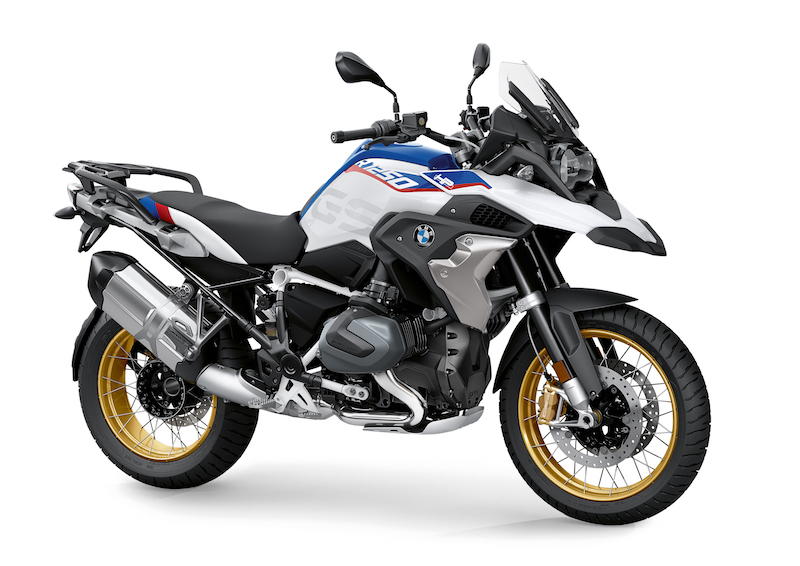
Specs at a glance
Engine Air/liquid-cooled, 2-cylinder, four-stroke boxer engine with all-new BMW Shift Cam system
Displacement 1254cc
Maximum power 136bhp @ 7,750rpm
Suspension Front; BMW Telelever with central spring strut. Rear; BMW Paralever and WAD Spring Strut. Adjustable.
Brakes Front; twin 305mm floating discs with radial 4-pison calipers. Rear; 276mm disc with 2-piston caliper
Tyres Front; 120/70 19” Rear; 170/60 17”
weight 249kg
Tank capacity 20L
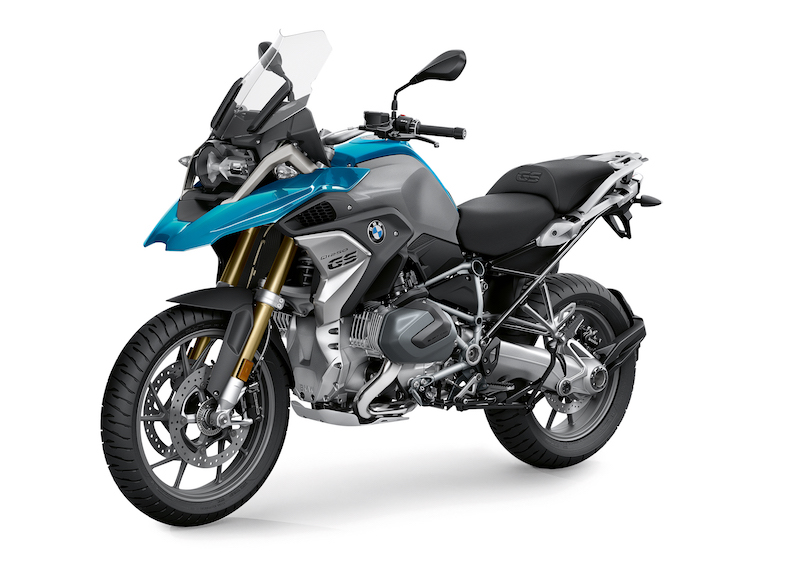
The five GS variants
R 1250 GS – £13,415
- TFT Sceen with connectivity
- Full LED Headlight
- Hand guards
- Hill start control
- L & R pannier fastenings
- Automatic Stability Control
- Rain and road riding modes
R 1250 GS Rallye – £13,950
- HP Style Package – HP colour – gold calipers
- Full LED headlight
- Radiator and frame guard
- L & R pannier fastenings
- Hand guards
- Automatic Stability Control
- Rain and road riding modes
- Hill start control
- Cross spoke wheels – black
- Sports windshield
- Black powertrain
- Wide enduro footpegs
R 1250 GS TE – £16,200
- As standard GS, plus:
- Dynamic traction control
- Dynamic ESA
- Keyless ride
- Daytime riding light
- Radiator and frame guard
- Gear shift assist pro
- Riding modes pro – Includes Dynamic Pro, Enduro and Enduro Pro
- Chrome exhaust
- Preparation for GPS
- Heated grips
- Tyre pressure control
- Cruise control
- LED indicators
- ABS Pro with dynamic brake light
R 1250 GS Exclusive TE – £16,500
As GS TW, plus:
- Exclusive style package – Black Storm Metallic – frame Achat Grey – Gold calipers
- Black powertrain
- Hand guards
R 1250 GS Rallye TE – £16,975
As GS Rallye model, plus:
- Passenger kit – standard seat, windshield and main centre stand
- Dynamic traction control
- Dynamic ESA
- Keyless ride
- Daytime riding light
- Gear shift assist pro
- Riding modes pro – Includes Dynamic Pro, Enduro, and Enduro Pro
- Chrome exhaust
- Preparation for GPS
- Heated grips
- Tyre pressure control
- LED indicators
- Cruise control
- ABS Pro with dynamic brake light
- On-board computer pro

